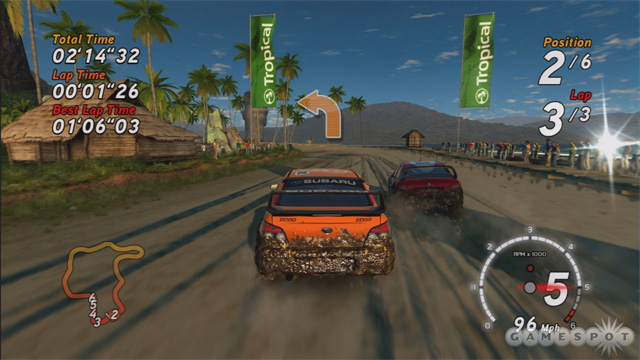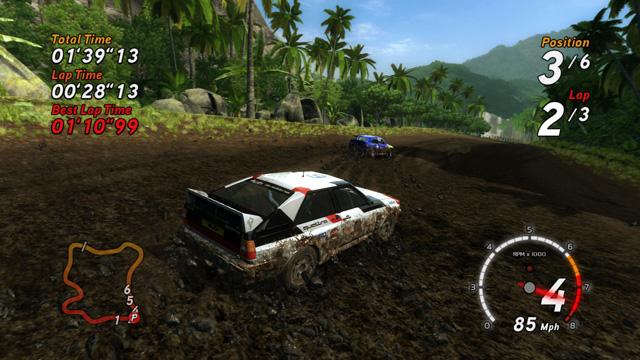-- Review written October 2007
Barring Gamespot's "history" lesson on the Sega Rally series, the reviewer makes it abundantly clear that he thinks down upon arcade style gaming.
 Having only a "scant" number of tracks and cars, when compared to
modern racers with entirely different focuses, is not a deficiency for Sega
Rally Revo. Reviewers have said in the past that a good game manages 10-30 seconds
of "fun" and then manages to repeat it over and over. Similarly, while
Sega themselves lost their magic years ago, Sega Racing Studio clearly understands
what Sega racers are supposed to be.
Having only a "scant" number of tracks and cars, when compared to
modern racers with entirely different focuses, is not a deficiency for Sega
Rally Revo. Reviewers have said in the past that a good game manages 10-30 seconds
of "fun" and then manages to repeat it over and over. Similarly, while
Sega themselves lost their magic years ago, Sega Racing Studio clearly understands
what Sega racers are supposed to be. Sega racers, like all Sega games before the PS2's days, were always easy to pick up and play and rewarding to master. Perhaps more significantly, Sega racers always gave the player a feeling of being on the bleeding edge of losing control, and yet you could control it all. This is true of the Outrun, Daytona and Sega Rally games. The fact that multi-player was always a component of these games was also not lost on Sega Racing Studio.
In Sega Rally, the game presents this dialectic of chaos and control by means of the powerslide mechanic, and the unique physics of how the tires interact with the road. While a driving simulation would punish the player for oversteering by spinning the car and stopping the action, Sega Rally emphasizes flow and speed. Gamers with a bent toward Gran Turismo, Forza, and Toca will have a knee-jerk reaction to this and assume that the gameplay is "shallow." This sort of narrow mindedness is what makes modern gameplay so limited. It is possible to spin your car in Sega Rally, but the player really has to screw up for this to happen.
 The game does punish
the player for hitting walls, but it does everything it can to keep the action
flowing without giving the player an easy road. Only a head on collision with
a track side object will result in a full stop. Otherwise the car will careen
off the object, and the player will have to struggle to regain control and down
shift one to three gears to get back into the race. Aside from steering clear
of the walls, Sega Rally adds the dynamics of traction with various types of
surfaces. So, while the player is attempting to make a turn, or speed up on
the straightaways, dodging water puddles or staying on asphalt is also part
of the game. The challenge comes in from trying to do all of this while avoiding
the other (ghost) cars. While the other cars are not AI by modern standards,
they do present a challenge by being both obstacles and progressively challenging
times to beat.
The game does punish
the player for hitting walls, but it does everything it can to keep the action
flowing without giving the player an easy road. Only a head on collision with
a track side object will result in a full stop. Otherwise the car will careen
off the object, and the player will have to struggle to regain control and down
shift one to three gears to get back into the race. Aside from steering clear
of the walls, Sega Rally adds the dynamics of traction with various types of
surfaces. So, while the player is attempting to make a turn, or speed up on
the straightaways, dodging water puddles or staying on asphalt is also part
of the game. The challenge comes in from trying to do all of this while avoiding
the other (ghost) cars. While the other cars are not AI by modern standards,
they do present a challenge by being both obstacles and progressively challenging
times to beat.Failing to understand this gameplay dynamic will result in the assumption that the "fun" that Sega Rally Revo presents is limited to how many tracks and cars are available. The dynamic of differing controls between cars and memorizing different tracks is, at best, of tertiary importance to a proper arcade racer. In fact, adding more tracks and cars can be a detriment to a game like this. DVD generation game players are already predisposed to think that added content equates to more enjoyment. In a game like Sega Rally it can be quite the opposite, as the player will have to break the flow of the action and speed to learn each new track and car. In a game that presents such a great effort to *not* break the flow or the speed, additional tracks and cars are of limited importance.